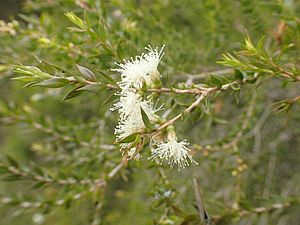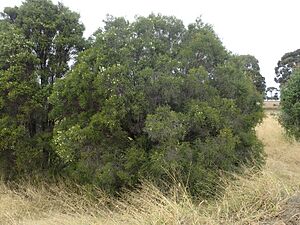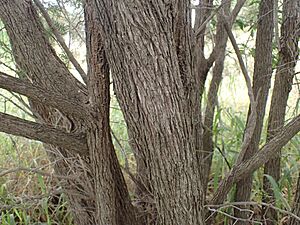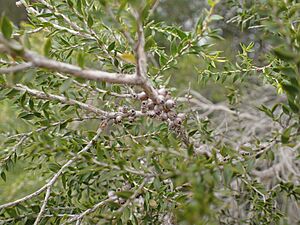Melaleuca squamophloia facts for kids
Quick facts for kids Melaleuca squamophloia |
|
|---|---|
 |
|
| Leaves and flowers of M. squamophloia | |
| Scientific classification | |
| Genus: |
Melaleuca
|
| Species: |
squamophloia
|
Melaleuca squamophloia is a special plant. It belongs to the myrtle family, called Myrtaceae. This plant grows only in the black soil plains of southeastern Queensland, Australia. This means it is endemic to that area.
It is a small, upright tree. It has prickly leaves and spikes of cream or white flowers. It is similar to its close relative, Melaleuca styphelioides. However, Melaleuca squamophloia has hard bark, not papery bark. Its leaves also have fewer veins than its relative.
What Does Melaleuca squamophloia Look Like?
Melaleuca squamophloia can be a shrub or a small tree. It can grow up to 7 m (20 ft) tall. Its bark is hard and can look scaly or stringy.
Its leaves grow one after another along the stem. They are 4–12 mm (0.2–0.5 in) long and 1.6–3.5 mm (0.06–0.1 in) wide. The leaves are shaped like a narrow egg. They have a sharp, prickly point at the end. Each leaf has 3 to 15 veins.
The flowers are white or cream-colored. They grow in spikes at the ends and sides of the branches. The branches keep growing even after the flowers appear. Each spike has 5 to 16 individual flowers. The spikes can be up to 20 mm (0.8 in) across.
The petals are 1.5–1.8 mm (0.06–0.07 in) long. They fall off when the flower opens or soon after. Each flower has five groups of stamens. Stamens are the parts that make pollen. Each group has 15 to 20 stamens.
This plant flowers in spring and from April to June. After flowering, it produces fruit. The fruit are woody, round capsules. They are 2.5–3.5 mm (0.098–0.14 in) long.
How Did It Get Its Name?
The plant Melaleuca squamophloia was first officially named in 1997. This was done by Lyndley Craven and Bryan Barlow. Before that, in 1984, Norman Byrnes had described it as a type of Melaleuca styphelioides.
The second part of its name, squamophloia, tells us something about the plant. It comes from two words. Squama is a Latin word meaning "scale." Phloiós is an Ancient Greek word meaning "bark." So, the name refers to the hard, scaly bark of this plant.
Where Does Melaleuca squamophloia Live?
This melaleuca plant grows in southeastern Queensland, Australia. You can find it on the black soil plains. It grows in areas around Miles, Jandowae, and Tara. It likes to grow in woodlands and scrubland. It prefers clay and clay loam soils.




